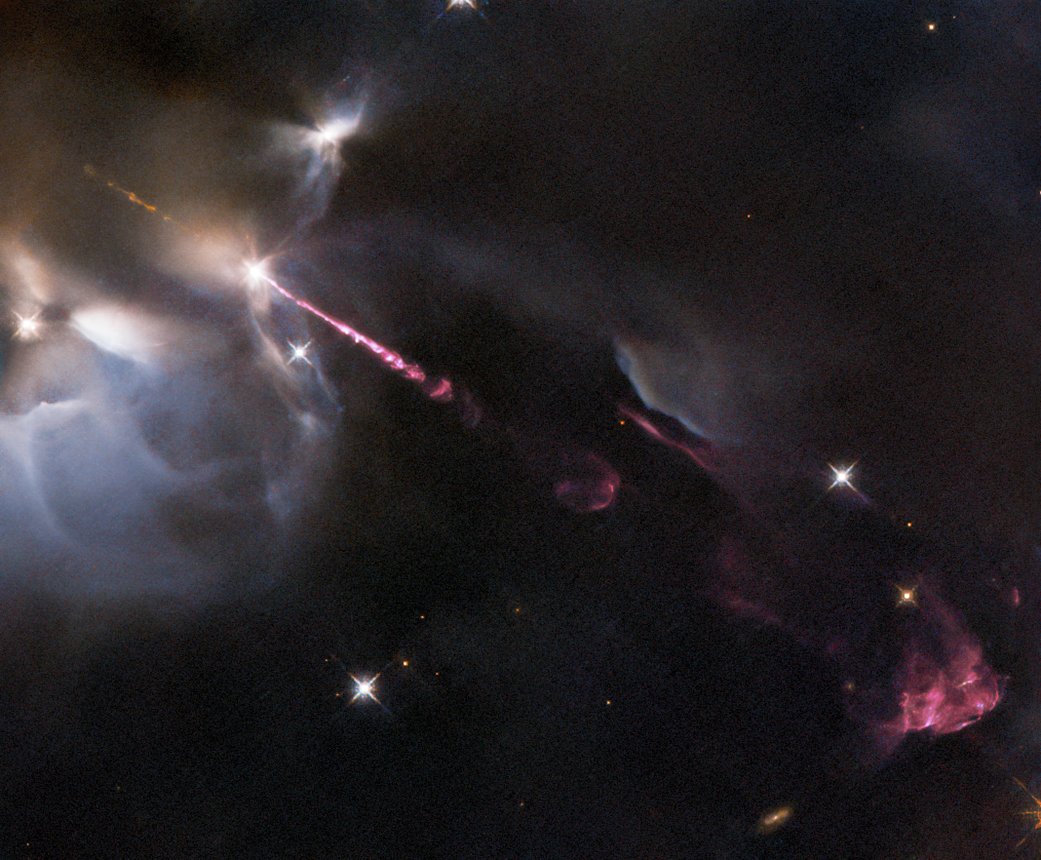An energetic outburst from an infant star streaks across this image from the NASA/ESA Hubble Space Telescope. This stellar tantrum – produced by an extremely young star in the earliest phase of formation – consists of an incandescent jet of gas travelling at supersonic speeds. As the jet collides with material surrounding the still-forming star, the shock heats this material and causes it to glow. The result is the colorfully wispy structures, which astronomers refer to as Herbig–Haro objects, billowing across the lower right of this image.
Herbig–Haro objects are seen to evolve and change significantly over just a few years. This particular object, called HH34, was previously captured by Hubble between 1994 and 2007, and again in glorious detail in 2015. HH34 resides approximately 1,250 light-years from Earth in the Orion Nebula, a large region of star formation visible to the unaided eye. The Orion Nebula is one of the closest sites of widespread star formation to Earth, and as such has been pored over by astronomers in search of insights into how stars and planetary systems are born.
The data in this image are from a set of Hubble observations of four nearby bright jets with the Wide Field Camera 3 taken to help pave the way for future science with the NASA/ESA/CSA James Webb Space Telescope. Webb – which will observe at predominantly infrared wavelengths – will be able to peer into the dusty envelopes surrounding still-forming protostars, revolutionizing the study of jets from these young stars. Hubble’s high-resolution images of HH34 and other jets will help astronomers interpret future observations with Webb.
Text credit: European Space Agency
Image credit: ESA/Hubble & NASA, B. Nisini
这张由NASA/ESA哈勃太空望远镜拍摄的照片中,一颗新生恒星爆发出的能量横扫了这张照片。这种恒星爆发——由一颗极年轻的恒星在形成的最早阶段产生——由一股以超音速飞行的炽热气体喷流组成。当喷流与仍在形成的恒星周围的物质碰撞时,冲击会加热该物质并使其发光。结果是在这张图片的右下方,出现了色彩斑斓的纤细结构,天文学家称之为赫比格-阿罗天体。
赫比格-阿罗天体在短短几年内就发生了显著的演变和变化。这颗被称为HH34的特殊天体之前曾在1994年至2007年间被哈勃望远镜捕捉,2015年又一次被哈勃捕捉到了精彩的细节。HH34位于猎户座星云中,距离地球约1250光年,这是一个肉眼可见的恒星形成的大区域。猎户座星云是距离地球最近的广泛恒星形成地点之一,因此天文学家一直在仔细研究,以寻找有关恒星和行星系统如何诞生的见解。
这张图片中的数据来自哈勃望远镜使用广角相机3号相机对附近四个明亮喷流的一组观测数据,这是为了帮助NASA/ESA/CSA詹姆斯·韦伯太空望远镜为未来的科学铺平道路。韦伯将以红外波长为主进行观测,它将能够窥视仍在形成的原恒星周围的尘埃包层,从而彻底改变对这些年轻恒星喷流的研究。哈勃对HH34和其他喷流的高分辨率图像将有助于天文学家用韦伯解释未来的观测结果。
文字来源:欧洲航天局
图片来源:欧洲航天局/哈勃和美国宇航局,B.尼西尼







